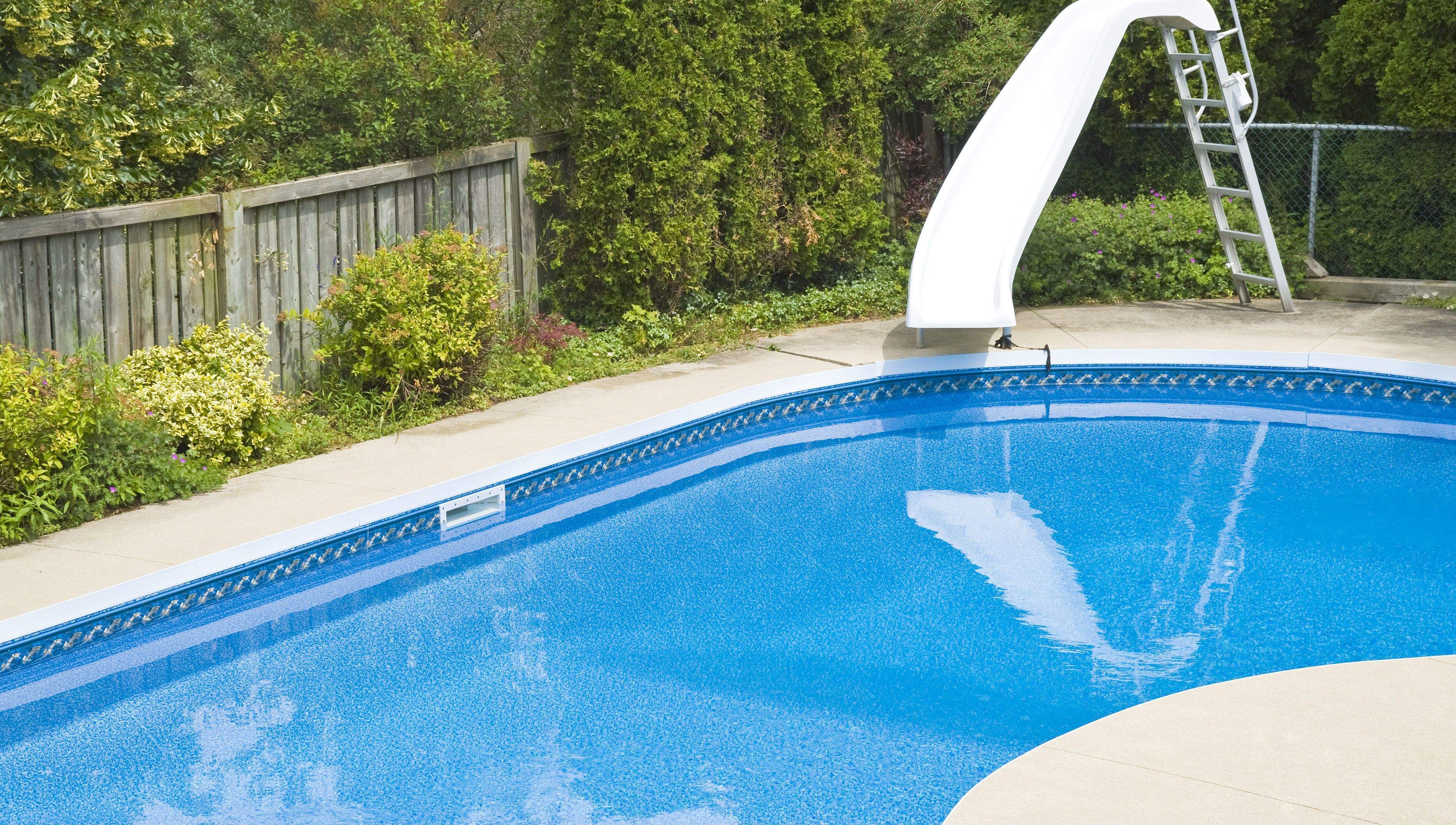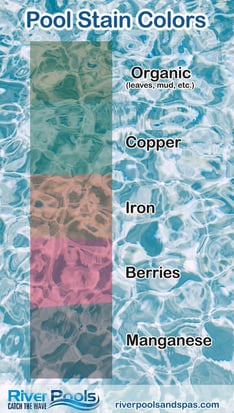
How to Remove Stains from a Pool Liner
Pool Maintenance | Vinyl Liner Pool Information
Have you ever spilled cola or red wine on a brand new carpet? Yeah, it’s not fun.
Know what else isn’t fun? A stained pool liner.
Knocking your cocktail into your swimming pool probably won’t stain your pool liner, but a lot of other things will.
Full disclosure, we manufacture fiberglass pools, exclusively. But long before we began manufacturing many of our team members were becoming well versed in many facets of the swimming pool industry, including vinyl liner pools. So today we’re going to suggest how to identify, remove, and prevent stains on a vinyl pool liner.
Let’s face it, it’s the part of pool ownership that nobody likes, but until someone makes a giant washing machine for vinyl pool liners, here’s what you can do:
How to Identify Pool Liner Stains
Stains typically come from either organic buildup or metals in the pool.
Organic stains are usually brown or green and come from:
- Dirt
- Mud
- Leaves
- Algae
- Bugs
- Other organic debris
Metal stains come in a wide range of colors and are typically caused by:
- Metal pool parts (ladders)
- Corroded pool pipes
- Pool heaters
- Water
Pool liner stains can be caused or worsened by not properly maintaining the pool water chemistry. Think of your pool's water chemistry like a perfectly balanced diet. Just as too much or too little of certain nutrients can affect your health, imbalanced pool chemicals can lead to stains and other issues.
Liner Pool Stain Colors
By looking at the color, it’s not always easy to tell what’s causing the stains. Sometimes, there’s a dead giveaway next to your stain that tells you where it came from (like a rusty ladder or pile of decaying leaves), but sometimes you’re going to have to look for other clues to find out what’s causing it.
Here are a few colors that you may see and their possible causes:
- Teal or blue-green stains indicate that you might have an issue with copper. The copper stains could be originating from pipes or they could be leaching from the pool heater due to improper chemical maintenance.
- Reddish-brown stains typically come from iron in the pool. Sometimes, the pool liner will also be stained yellow. These rusty patches on the liner can come from metal parts, like handrails or ladders, but they can also be caused by corroded iron pipes or well water that services the home.
- Green or brown stains on pool liners usually come from organic matter like algae, leaves, bugs, and mud.
- Red or purple stains often come from berries or fruit falling into the pool from nearby bushes or overhead trees. Light pink stains can also be a sign of bacterial buildup.

Test Your Pool Water
If you think you might have a metal stain or you’re just unsure of what’s causing your pool liner stains, you can buy a stain test kit. A stain test kit may help you determine what is causing the stain.
Pro tip: You can always call in a professional to help you diagnose and treat the stains in your pool.
How to Remove Pool Liner Stains
By now, you’ve probably realized that not all pool stains are created equal. That means that each one has to be treated slightly differently to achieve a stain-free liner. Let’s start with the more common organic stains.
How to Remove Organic Stains from a Vinyl Pool Liner
Some stains are trickier to remove than others, with organic stains usually being easier to treat and eliminate than metal stains. If your stains are organic, here’s what you can do:
- Remove debris and leaves from the pool and clean the filter.
- Brush the pool surface with a liner-friendly brush to loosen grime, dirt, and algae.
- Vacuum the surface of the pool (using a liner friendly vacuum) to get rid of remaining leaves, dirt, and debris.
- Make sure your pool water chemistry is balanced. Test the water and balance your chemicals according to the liner manufacturer’s recommendations. (After this step, you may find that your stains have faded significantly.)
- Shock the pool using the liner manufacturer's recommendations. Brushing the stain after shocking your pool may help expedite the removal process.
This method is usually effective for most organic stains, but you can also try a few more things to tackle stubborn organic stains in the pool liner:
- Use a pool liner stain remover (make sure the product is specifically made for liner pools). Some of these can be used both above and below the waterline.
- Wipe the stain directly with a cloth and cleaner. Again, use a product made for pool liners and avoid household cleaners. Be careful with chlorine as well because it can bleach away your pool liner pattern if concentrated heavily in one spot.
- Use a stain eraser tool made for cleaning pool liners (available online and in pool supply shops).
- If none of these methods fade the stain, you can always call in a pool service professional to assist.
How to Remove Metal Stains from a Pool Liner
Note - this process can be a little more difficult and time-consuming than treating organic liner stains. Here’s where you can start:
- Look for obvious sources of metal staining in the pool (like rust around ladders and handrails).
- Assess the color of the stain to determine what the source may be.
- Clean the pool and balance your pool chemistry.
- Test the pool for metals using a metal test kit.
- Once you have confirmed the presence of metals in your pool, eliminate them with a metal sequester. A metal sequester is a chemical that binds to metals in the water to prevent them from causing stains in the pool. It “holds” the metals to minimize their impact on your pool and water.
- Identify the cause of the stains and correct the issue. You may need to change your water source, replace your ladder, or fix corroded pipes.
- Regularly test for metals, balance your water chemistry on a weekly basis, and continue using metal sequesters to catch metals before they can stain the liner.
If you need help getting rid of stubborn stains, you can try using a metal stain remover for vinyl liners and/or a stain-removing tool. You can wipe the stain directly with a clean cloth or use a brush or another liner cleaning tool to get at hard to reach spots.
Are the stains not coming out? You might be tempted to drain your pool to get a closer look at them, but we strongly advise against doing this. Draining your pool can damage your liner or pool walls, problems that are way bigger than any stain no matter how ugly it is.
If you think it is necessary to drain your pool, call a professional who can help you out and give you personalized advice.
If all else fails, you can replace your pool liner. Modern pool liners only last about 5-9 years on average, so if you’ve had yours for about that long, you might want to go ahead and start fresh.
Read more: Vinyl Pool Liner Replacement: Cost, Steps, Tips
What if your pool steps have stains, but they’re made of fiberglass?
Tackling fiberglass stains is going to require a different set of rules. You can read about removing stains from a fiberglass surface here.
For a brief recap on how to remove stains from fiberglass, here are a few tips to consider:
- Maintain your water chemistry
- Don’t let leaves or dirt sit on your pool steps
- Try wiping stains off with a fiberglass friendly sponge or cloth
- For metal stains, try rubbing a vitamin c tablet directly onto small stains
- Try a metal sequestering agent to fade the stain and remove metals
Tips to Prevent Pool Liner Stains
Preventing pool stains is like applying sunscreen. It's much easier to prevent the damage in the first place than to treat it after it occurs. Below are some tips listed that in our experience, can be helpful ways to prevent pool liner stains.
- Keep your pool chemistry balanced according to the manufacturer’s recommendations
- Keep debris out of the pool, and don’t let leaves or dirt sit on steps or pool floor
- Use metal sequesters to keep metals from building up again if you’ve had problems with it in the past
- Try using a pool cover to keep dirt and debris out
- Brush and vacuum your pool once a week
At River Pools, we manufacture world class fiberglass pools for homeowners across North America. Fiberglass pools are generally viewed as easier to maintain, and they resist algae better than plaster and vinyl pool liners.
If you're interested in exploring your fiberglass pool options, feel free to check out our catalog of models, try out our fiberglass pool pricing calculator, or request custom pricing using the button below.
And don't forget to download your free ebook to get an in-depth comparison of fiberglass, concrete, and vinyl liner swimming pools.
Up Next:
Vinyl Liner Pool Basics: Pros, Cons, and How They’re Made
How Long Do Vinyl Liner Pools Last?
How Much Does It Cost to Replace a Vinyl Liner Pool with Fiberglass?
Editor's note: This article was originally written by Marcus Sheridan and was updated on September 30, 2024 with current information. River Pools is a brand of inground fiberglass pools produced in a manufacturing facility in Fortville, IN. While our expertise is in manufacturing fiberglass pools, we have access to a network of installers with expertise relating to project design, installation, and pool service. We often tap into this knowledge base and share information freely with homeowners, just like you, considering installing a swimming pool in your backyard.





